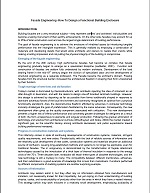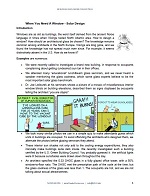Glass Coolness – Additional Clarification
This is a follow-up to the post titled “Glass Collness.”
In response to my critique of the FBC insulated glass requirement in the South Florida, we received a question from an architect, who wrote: “Surely you would not claim that double glazing with a low-e coating on the #2 surface would cause more energy use in the building than single glazing, would you?”
Well, this was exactly what I meant. I was comparing the two code-compliance states: before and after the new regulation. Before, we had to use a low-E laminated glass, now we need to use a low-E laminated and insulated glass. (There would be also some possible combinations of tinting and overhangs in order to reach the code-mandated SHGC 0.25 just to be precise, but we would not discuss them here for clarity.) So I was comparing two low-E glasses, insulated and not along lines: “if we replaced a car windshield with an insulated glass, the interior plastics would melt away because the heat would not be able to escape as quickly as before.”
Since it was just my intuitive understanding, we made an experiment. The experiment is described in the new “Hot and Humid” seminar, also available in DVD format. We took two pieces of low-E coated glass: one laminated and insulated and the other just laminated. Both were coated with the same high-performance low E coating from a leading manufacturer. We also have a styrofoam box; scientists sometimes call this device a calorimeter, ordinary people call it a cooler. We placed each of them on top of a cooler box and left in sun for 10 minutes, then swapped with the other, waited 10 minutes and swapped again, etc. We inserted a temperature gauge (meat thermometer) in the box to measure the ambient air inside. Edges were taped with blue painter’s tape and the air movement was monitored, so we knew the exterior air was practically still. We measured surface temperatures during each swap with a pyrometer.
After several swaps, once the temperature stabilized and the box reached equilibrium with the surroundings, the ambient temperature in the box increased 2 degrees every time after an IGU was installed and dropped 2 degrees every time after single glass was installed. The insulated glass caused also approximately 20 degrees higher temperature of the black lining placed on the bottom of the box, in comparison to the non-insulated glass.
So, using the analogy with a car, you can imagine the interior surfaces in your car would be comparatively ~20 degrees hotter if the windows were insulated, everything else being equal. It would take your air conditioning quite a time and extra energy to remove the extra heat.
This would apply only to the fenestration exposed to the direct sun. If we have enough time, we would also run a whole-building energy simulation to compare the effect of a quicker dissipated NIR gain with the higher long-wave infrared gain (e.g. in the nighttime). To get a full picture, we would also conduct life cycle analysis, including the environment impact craddle-to-grave, in addition to the annual energy cost comparison. The insulated glass has a relatively short lifespan, yet it’s twice that of the laminated glass in a hot and humid environment.
We will keep you posted.
Update: It turns out someone else already simulated it, coming to the same conclusion: Mikkel Kragh and Annalisa Simonella of Arup in their ICBEST 2007 paper: “A Missing Correlation between insulation and energy performance,” available here: http://www.facadeengineeringsociety.org/news/SFE%20elevation%203.pdf. Here is the excerpt from their paper: “In situations with relatively high solar gains, an increased level of thermal insulation may lead to higher energy consumption as heat is‘trapped’ within the perimeter zone.”


 Condensation Risk Assessment
Condensation Risk Assessment Facade Access
Facade Access Facade Engineering. How To Design a Functional Building Enclosure
Facade Engineering. How To Design a Functional Building Enclosure Facade Impact Resistance Manual
Facade Impact Resistance Manual Foggy Glass Disease
Foggy Glass Disease How To Write and Read a Forensic Report
How To Write and Read a Forensic Report Movements and Tolerances
Movements and Tolerances Review of Curtain Walls, Focusing on Design Problems and Solutions
Review of Curtain Walls, Focusing on Design Problems and Solutions Transitions: How to Design Facade Interfaces
Transitions: How to Design Facade Interfaces When You Need A Window – Solar Design
When You Need A Window – Solar Design
July 18th, 2011 at 10:33 am
[…] 07/18/2011. Additional Clarification by Kaz is posted Here. […]
December 19th, 2012 at 9:22 am
[…] 07/18/2011. Additional Clarification by Kaz is posted Here. […]